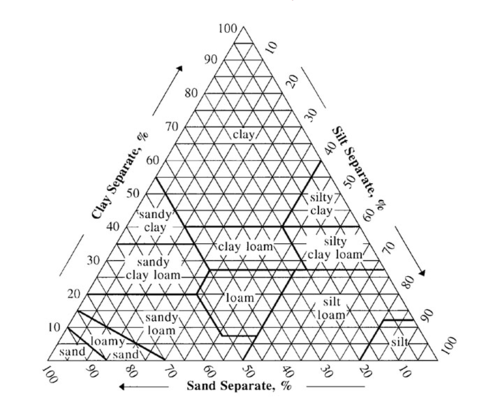This test is a simple way to discover what soil texture in the tested soil, allowing you to work out what percentages the soil has of sand, silt and clay.[1] It's simply a matter of watching where the particles settle out of water within the jar, then estimating the contents by observing the marked lines you make during the experiment.
Taking the jar test[edit | edit source]
- Obtain a suitable soil sample. Choose the area where you'd like to take the soil test. Remove the top layer of soil with plant and organic matter in it, so that you can reach the mineral layer of soil. The mineral soil will be about 1.3cm (1/2 an inch) from the top. Dig down about 20cm (8 inches) into the soil. Use a trowel to lift out a soil sample from the edge of the hole the whole way down (allowing you to collect the soil from the whole depth).
- Repeat this in various different areas across the garden or yard. Combine the different samples taken in a bucket or large container (such as a painter's pail). Stir to mix together.
- Fill a jar about halfway with the mixed soil sample. The jar should be about 950ml or 1 quart in size.
- Use a permanent marker suitable for glass to mark the top of the soil as it is currently sitting in the jar. This tells you where the soil comes to when dry.
- Add enough water to the jar to fill it to two-thirds of the way. Place the lid on top and shake well. Shake for three minutes.
- Place the jar down and let the soil settle for half a minute. Mark a line to show the top of the soil. This gives you a rough estimate of the amount of sand in the soil.
- Wait anther three minutes. Mark a line again to show where the top of the soil is. This provides a rough estimate of how much silt is in the soil. There should now be two clear layers, the lower layer being sand and the upper layer being silt.
- Using the original line drawn when the soil was dry, you can now estimate the total amount of sand and silt that make up the total amount of the soil sample. The remaining amount you've not marked will be clay (particles above the silt line), giving you three final percentages.
Assessing the soil sample results[edit | edit source]

Use the USDA soil texture calculator above to estimate your soil's texture.
- Use the sand line along the base of the triangle, finding the relevant percentage amount.
- Use the silt line along the right hand side of the triangle, finding the relevant percentage amount. Follow this to where it meets the sand line. You'll find your soil's textural type, where the lines intersect.
- Trace from here to the line on the left hand side and you'll find out the clay percentage in the soil.
Sources and citations[edit | edit source]
- ↑ Murphy, E. (2015), Building Soil
- Jar test adapted from Elizabeth Murphy, (2015) Building Soil: A Down-to-Earth Approach, ISBN 978-1-59186-619-0